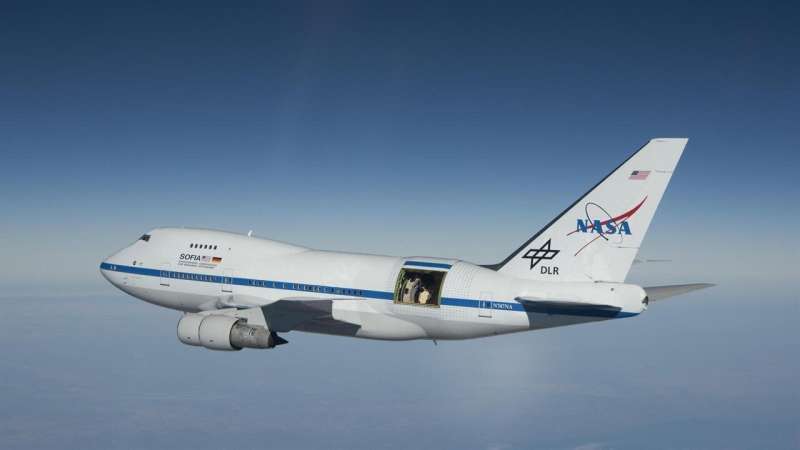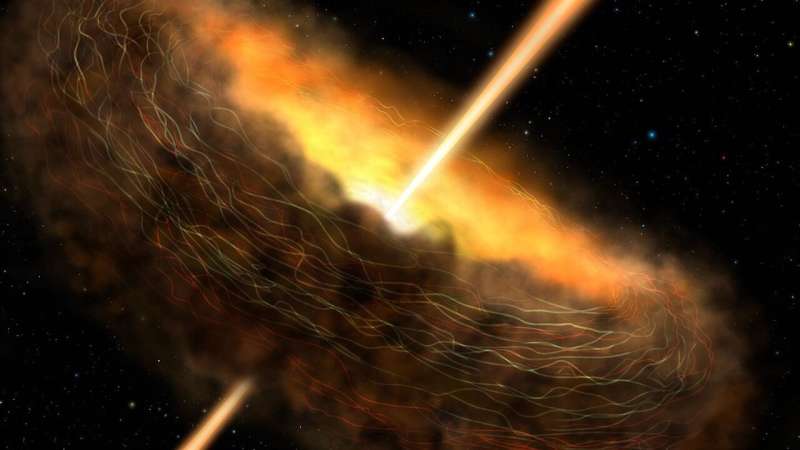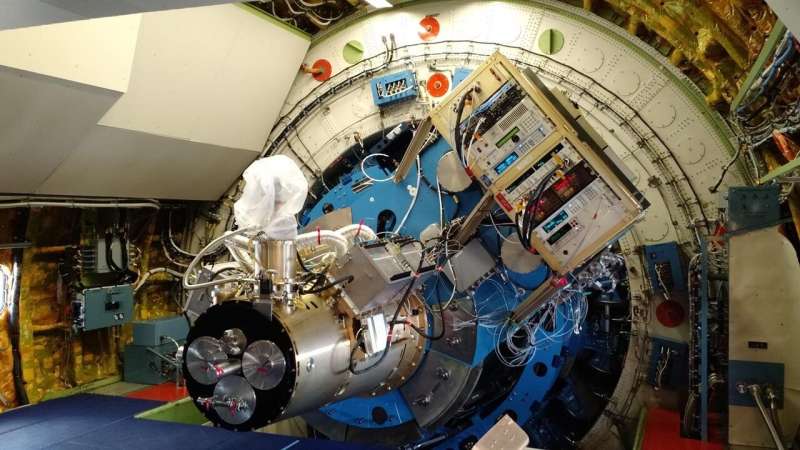SOFIA in Stuttgart: First scientific research flight over Europe

On 16 September 2019 at 04:14 CEST, the Stratospheric Observatory for Infrared Astronomy (SOFIA) is expected to land at Stuttgart Airport. The airborne observatory is a joint project by the US space agency NASA and the German Aerospace Center (Deutsches Zentrum für Luft- und Raumfahrt; DLR). SOFIA is scheduled to take off from Stuttgart at 19:40 CEST on 18 September for its first scientific research flight over Europe, during which it will fly over 12 countries. The idea behind this is that, during its European mission, SOFIA will fly much farther north than it is able to when taking off from its home base in Palmdale, southern California. The closer the infrared observatory is able to fly to the poles, the less water vapour is present in the atmosphere above it, offering improved observing conditions.
"This is a very special occasion—SOFIA will be taking off from Stuttgart for its first European scientific research flight," says Pascale Ehrenfreund, Chair of the DLR Executive Board. "The researchers on board will be exploring the areas around black holes and looking into the question of whether Dark Energy really is causing the universe to expand at an ever-increasing rate."
Tracking star formation
Not only did humans first set foot on the moon 50 years ago in 1969, but NASA scientists also—somewhat by chance—discovered a very special galaxy. Markarian 231—in the Ursa Major constellation—is approximately 600 million light years from Earth. This is about 300 times further away than the Andromeda Galaxy, which is the closest galaxy to the Milky Way. Nonetheless, Markarian 231 is one of the nearest galaxies to Earth that is both extremely bright and has an Active Galactic Nucleus (AGN). Its luminosity in the infrared region of the spectrum makes Markarian 231 one of the brightest and best-known ultra-luminous infrared galaxies. Two black holes circle around one another at its center. One of them, at four million solar masses, is rather small; the other, which weighs 150 million solar masses, is much larger. Researchers are interested in looking at the area around these black holes during SOFIA's first European flight. A dust torus surrounds them.

These donut-shaped regions are found around every AGN. However, the role that they play in generating radio jets remains unclear. These are pairs of plasma jets that are ejected from the centre of an AGN at relativistic velocities. Not every AGN produces such radio jets, as has been shown by radio astronomy observations. Previous studies with SOFIA have indicated that the magnetic field in these dust-laden tori may help to trigger radio jet formation. Can the creation of the jets really be traced back to the presence—or indeed the absence—of a magnetic field? This is an important question to which astronomers have not yet found an answer.
Since only the High-resolution Airborne Wideband Camera (HAWC+) infrared instrument on SOFIA can measure magnetic fields in this wavelength range, the researchers want to use it to decipher the connection between these fields and radio jets. They began their observations of the AGN of Cygnus A during a flight over southern California in 2018. "SOFIA's first European mission will continue this research to finally solve the astronomical mystery of radio jets," explains Alessandra Roy, the German SOFIA Project Scientist at the DLR Space Administration, which operates the airborne observatory jointly with NASA.
Is the universe expanding at an accelerating rate?
The universe has been continuously expanding since the Big Bang. This discovery was made by Edwin Hubble in 1929. Then, in the late 1980s, the Nobel Prize-winning astrophysicists Saul Perlmutter, Adam Riess and Brian Schmidt began observing type 1a supernovae. These stellar explosions, referred to as 'cosmic lighthouses," are visible from far away and always have the same brightness. This allows their distances to be clearly determined, as the brighter these type 1a supernovae appear, the closer they are to the observer. Determining the brightness of many supernovae enabled researchers to ascertain whether or not the expansion of the universe is accelerating. The results came as a surprise. The observed stellar explosions were less luminous than expected.
This made it clear to the three researchers that the expansion is speeding up and the universe is being driven apart by a mysterious acceleration mechanism that is now referred to as Dark Energy. But is this really the case? Is the unexpectedly low luminosity due to the universe moving apart at increasing speed? Or was there some problem with the observations? "These are precisely the questions that researchers from Austin, Texas will be addressing as they use the HAWC+ instrument on board SOFIA to observe dust in the home galaxies of type 1a supernovae. They will measure the dust content in the region around the stellar explosion. Similar observations will also be performed by the European Space Agency's Euclid space telescope, which is scheduled for launch in 2022. After these observations, we will perhaps know more precisely whether the expansion of the universe is really accelerated by Dark Energy," explains Roy, who is involved in both the Euclid and SOFIA missions.

Europe's night sky—a treasure trove of cosmic secrets
A number of other scientific observations are planned during SOFIA's 10-hour flight. Astronomers from the Smithsonian Astrophysical Observatory in Cambridge, Massachusetts, will be targeting the Serpens South region of the Serpens cloud—a formation with extremely young stars—from the sky above France. With these three- to four-million-year-old stars, researchers can follow star formation almost from its very inception and find out more about this process. The next observation will focus on the L 1495 filament in the Taurus Molecular Cloud. Researchers at the University of California, Berkeley (U.S.) want to find out what role the dynamics of magnetic fields play in the formation process of filamentary clouds. "This will be SOFIA's longest single observation on its first observation flight in Europe. The journey will begin south of the Swedish coast, over the Baltic Sea, and cross Poland, the Czech Republic, Austria, Slovenia, Croatia, the Adriatic Sea and Italy—almost as far as Sicily," says Clemens Plank, Project Engineer for SOFIA at the DLR Space Administration, discussing the flight plan. This has had to be agreed in advance with all the relevant European air traffic authorities.
Young audience on board
Not just scientists will be on board for this exciting expedition. A team from the German children's television program "Sendung mit der Maus" (Broadcast with the Mouse) will give the Mouse's audience insights into SOFIA's research flight in a special show entitled "Telescopes and Infrared Astronomy." In addition, a winner of the "Jugend forscht" competition for young researchers will fly on board SOFIA during its European premiere.
Provided by German Aerospace Center





















